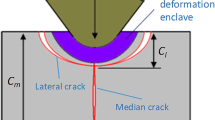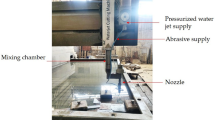Abstract
Laser and optics industries, are continueosly looking for glasses that posses excellent optical properties. Silica based glass BK7 is emerging as the pragmatic solution to meet these industrial needs that too with low fabrication cost. Conventional machining processes find it hard to process BK7 due to high hardness and low fracture toughness. In order to overcome the practical barriers of all the alternative processes, rotary ultrasonic machining has been attempted for drilling BK7. Taguchi based L9 array has been used for experimentation. Feed rate, tool rotational speed and ultrasonic power have been chosen as input variables. The drilling efficacy was evaluated considering the chipping width (CW), Taper (T) and material removal rate (MRR) as output responses. Main effects plots were drawn to reveal the effect of process variables on performance indices. ANOVA was used to identify the significant factors. It also figured out the extent to which significant factors influence the output responses. As Taguchi approach is not capable of simultaneous optimization of responses, TOPSIS approach was coupled with it for multi-response optimization. The predicted optimal solution, feed 0.60 mm/min, tool RPM 5000 and ultrasonic power 70% yielded the superior performance. The dominance of feed over other input factors made it the most crucial factor. Fractography highlighted the mixed flow of material at low feed rate, giving rise to superior surface finish. All the findings were confirmed experimentally as well as statistically. All the predicted results were found finely tuned with experimental results during confirmation experiments at 95% confidence level.
Similar content being viewed by others
Abbreviations
- CW:
-
Chipping width
- T:
-
Taper
- MRR:
-
Material removal rate
- TRS:
-
Tool rotational speed
- FR:
-
Feed rate
- UP:
-
Ultrasonic power
- ANOVA:
-
analysis of variance
- USM:
-
Ultrasonic machining
- RUM:
-
Rotary ultrasonic machining
- RUD:
-
Rotary ultrasonic drilling
- TOPSIS:
-
Technique for Order Preference by Similarity to Ideal Solution
- S/N:
-
Signal to noise ratio
- CWMEAN :
-
Mean value of chipping width
- TMEAN :
-
Mean value of taper
- MRRMEAN :
-
Mean value of material removal rate
- S/NCW :
-
Signal to noise ratio for chipping width
- S/NT :
-
Signal to noise ratio for taper
- S/NMRR :
-
Signal to noise ratio for material removal rate
- \( {\overline{CW}_m} \) :
-
Overall mean of chipping width
- \( {\overline{T}_m} \) :
-
Overall mean of taper
- \( {\overline{MRR}_m} \) :
-
Overall mean of material removal
- S− :
-
Negative best solutions
- S+ :
-
Positive best solutions
- Dm:
-
Decision matrix
- Nij :
-
Normalized decision matrix
- U:
-
Weighted normalized matrix
- \( {G}_{i}^{+} \) :
-
Distance of alternative from positive best solution
- \( {G}_{i}^{-} \) :
-
Distance of alternative from negative best solution
- PV:
-
Preference value
- C.I.:
-
Confidence Interval
References
Pal RK, Garg H, Sarepaka RV, Karar V (2016) Experimental investigation of material removal and surface roughness during optical glass polishing. Mater Manuf Process 31:1613–1620. https://doi.org/10.1080/10426914.2015.1103867
Barahimi V, Farahnakian M (2016) Experimental investigation of the surface roughness in grinding of BK7 optical glass in Brittle mode. J Mod Process Manuf Prod 5:33–41
Huu Loc P, Shiou F, Yu Z, Hsu W (2013) Investigation of optimal air-driving fluid jet polishing parameters for the surface finish of N-BK7 optical glass. J Manuf Sci Eng 135:1–7. https://doi.org/10.1115/1.4023368
Li HN, Yu TB, Zhu LD, Wang WS (2016) Evaluation of grinding-induced subsurface damage in optical glass BK7. J Mater Process Technol 229:785–794. https://doi.org/10.1016/j.jmatprotec.2015.11.003
Meral G, Sarıkaya M, Dilipak H, Şeker U (2015) Multi-response optimization of cutting parameters for hole quality in drilling of AISI 1050 steel. Arab J Sci Eng 40:3709–3722. https://doi.org/10.1007/s13369-015-1854-z
Rattan N, Mulik RS (2017) Experimental investigations and multi-response optimization of silicon dioxide (Quartz) machining in magnetic field assisted TW-ECSM process. Silicon 9:663–673. https://doi.org/10.1007/s12633-016-9521-x
Arooj S, Shah M, Sadiq S (2014) Effect of current in the EDM machining of aluminum 6061 T6 and its effect on the surface morphology. Arab J Sci Eng 39:4187–4199. https://doi.org/10.1007/s13369-014-1020-z
Hocheng H, Tsao CC (2005) The path towards delamination-free drilling of composite materials. J Mater Process Technol 167:251–264. https://doi.org/10.1016/j.jmatprotec.2005.06.039
Ning FD, Cong WL, Pei ZJ, Treadwell C (2016) Rotary ultrasonic machining of CFRP: a comparison with grinding. Ultrasonics 66:125–132. https://doi.org/10.1016/j.ultras.2015.11.002
Jain AK, Pandey PM (2016) Experimental investigations of ceramic machining using μ-grinding and μ-rotary ultrasonic machining processes: a comparative study. Mater Manuf Process 1–10. https://doi.org/10.1080/10426914.2016.1198024
Wang J, Feng P, Zhang J et al (2016) Modeling the dependency of edge chipping size on the material properties and cutting force for rotary ultrasonic drilling of brittle materials. Int J Mach Tools Manuf 101:18–27. https://doi.org/10.1016/j.ijmachtools.2015.10.005
Hocheng H, Tsao CC (2005) The path towards delamination-free drilling of composite materials. J Mater Process Technol 167:251–264. https://doi.org/10.1016/j.jmatprotec.2005.06.039
Hamzah E, Sudin I, Khoo C-Y, Abidin NNZ, Tan M-J (2008) Effect of machining parameters on BK7 Optical glass using conventionaland rotary ultrasonic machines. J JSEM 8:127–132. https://doi.org/10.11395/jjsem.8.s127
Chen S, Jiang Z, Wu Y, Yang H (2011) Development of a grinding—drilling technique for holing optical grade glass. Int J Mach Tools Manuf 51:95–103. https://doi.org/10.1016/j.ijmachtools.2010.12.001
Ning F, Wang H, Cong W, Fernando PKSC (2017) A mechanistic ultrasonic vibration amplitude model during rotary ultrasonic machining of CFRP composites. Ultrasonics 76:44–51. https://doi.org/10.1016/j.ultras.2016.12.012
Zhou M, Wang M, Dong G (2016) Experimental investigation on rotary ultrasonic face grinding of SiCp/Al composites. Mater Manuf Process 31:673–678. https://doi.org/10.1080/10426914.2015.1025962
Zou X, Wy N, Tian Y, Pei ZJ (2013) Cutting temperature in rotary ultrasonic machining of titanium: experimental study using novel Fabry-Perot fibre optic sensors. Int J Manuf Res 8:250–261. https://doi.org/10.1504/IJMR.2013.055242
Cong WL, Pei ZJ, Deines TW, Treadwell C (2011) Rotary ultrasonic machining of CFRP using cold air as coolant: feasible regions. J Reinf Plast Compos 30:899–906. https://doi.org/10.1177/0731684411416266
Cong W, Pei Z, Deines T, Wang Q (2010) Rotary ultrasonic machining of stainless steels: empirical study of machining variables. Int J Manuf Res 5:370–386. https://doi.org/10.1504/IJMR.2010.033472
Prakash S, Palanikumar K, Manoharan N (2009) Optimization of delamination factor in drilling medium-density fiberboards (MDF) using desirability-based approach. Int J Adv Manuf Technol 45:370–381. https://doi.org/10.1007/s00170-009-1974-2
Gadakh VS (2012) Parametric optimization of wire electrical discharge machining using topsis method. Adv Prod Eng Manag 7:157–164. https://doi.org/10.14743/apem2012.3.138
Walia RS, Shan HS, Kumar P (2006) Multi-response optimization of CFAAFM process through Taguchi method and utility concept. Mater Manuf Process 21:907–914. https://doi.org/10.1080/10426910600837814
Antil P, Singh S, Manna A (2017) Electrochemical discharge drilling of SiC reinforced polymer matrix composite using Taguchi’s Grey relational analysis. Arab J Sci Eng 43:1257–1266. https://doi.org/10.1007/s13369-017-2822-6
Churi NJ, Pei ZJ, Treadwell C (2006) Rotary ultrasonic machining of titanium alloy: effects of machining variables. Mach Sci Technol 10:301–321. https://doi.org/10.1080/10910340600902124
Kumar S, Singh AK (2017) Magnetorheological nanofinishing of BK7 glass for lens manufacturing. Mater Manuf Process 33:1188–1196. https://doi.org/10.1080/10426914.2017.1364759
Tsegaw AA, Shiou F-J, Lin S-P (2015) Ultra-precision polishing of N-Bk7 using an innovative self-propelled abrasive fluid multi-jet polishing tool. Mach Sci Technol 19:262–285. https://doi.org/10.1080/10910344.2015.1018532
Goswami A, Kumar J (2014) Optimization in wire-cut EDM of Nimonic-80A using Taguchi’s approach and utility concept. Eng Sci Technol an Int J 17:236–246. https://doi.org/10.1016/j.jestch.2014.07.001
Agarwal G, Patnaik A, Sharma RK (2014) Thermo-mechanical properties and abrasive wear behavior of silicon carbide filled Woven glass fiber composites. Silicon 6:155–168. https://doi.org/10.1007/s12633-014-9184-4
Kumar JS, Kalaichelvan K (2017) Taguchi-Grey multi-response optimization on structural parameters of honeycomb core sandwich structure for low velocity impact test. Silicon. https://doi.org/10.1007/s12633-016-9544-3
Daneshmand S, Monfared V, Lotfi Neyestanak AA (2017) Effect of tool rotational and Al2O3 powder in electro discharge machining characteristics of NiTi-60 shape memory alloy. Silicon 9:273–283. https://doi.org/10.1007/s12633-016-9412-1
Churi NJ, Pei ZJ, Treadwell C (2006) Rotary ultrasonic machining of titanium alloy: effects of machining variables. Mach Sci Technol 10:301–321. https://doi.org/10.1080/10910340600902124
Jiao Y, Hu P, Pei ZJ, Treadwell C (2005) Rotary ultrasonic machining of ceramics: design of experiments. Int J Manuf Technol Manag 7:192–206. https://doi.org/10.1504/IJMTM.2005.006830
Li ZC, Jiao Y, Deines TW et al (2005) Rotary ultrasonic machining of ceramic matrix composites: feasibility study and designed experiments. Int J Mach Tools Manuf 45:1402–1411. https://doi.org/10.1016/j.ijmachtools.2005.01.034
Sharma P, Chakradhar D, Narendranath S (2017) Analysis and optimization of WEDM performance characteristics of Inconel 706 for aerospace application. Silicon. https://doi.org/10.1007/s12633-017-9549-6
Zhang CL, Feng PF, Pei ZJ, Cong WL (2013) Rotary ultrasonic machining of sapphire: feasibility study and designed experiments. Key Eng Mater 589–590:523–528. https://doi.org/10.4028/www.scientific.net/KEM.589-590.523
Cong WL, Feng Q, Pei ZJ et al (2012) Edge chipping in rotary ultrasonic machining of silicon. Int J Manuf Res 7:311–329. https://doi.org/10.1504/IJMR.2012.048699
Zhang C, Cong W, Feng P, Pei Z (2013) Rotary ultrasonic machining of optical K9 glass using compressed air as coolant: a feasibility study. Proc Inst Mech Eng Part B J Eng Manuf 228:504–514. https://doi.org/10.1177/0954405413506195
Feng Q, Cong WL, Pei ZJ, Ren CZ (2012) Rotary ultrasonic machining of carbon fiber-reinforced polymer: feasibility study. Mach Sci Technol 16:380–398. https://doi.org/10.1080/10910344.2012.698962
Zeng WM, Xu XP, Pei ZJ (2006) Rotary ultrasonic machining of advanced ceramics. Mater Sci Forum 532–533:361–364. https://doi.org/10.4028/www.scientific.net/MSF.532-533.361
Wang J, Feng P, Zhang J et al (2017) Investigations on the critical feed rate guaranteeing the effectiveness of rotary ultrasonic machining. Ultrasonics 74:81–88. https://doi.org/10.1016/j.ultras.2016.10.003
Wu J, Weilong Cong ZP, Williams RE (2009) Stochastic modeling and analysis of rotary ultrasonic machining. In: Proceedings ASME International Manufacturing Science and Engineering Conference, pp 1–10
Zhang QH, Wu CL, Sun JL, Jia ZX (2000) The mechanism of material removal in ultrasonic drilling of engineering ceramics. Proc Inst Mech Eng Part B J Eng Manuf 214:805–810. https://doi.org/10.1243/0954405001517874
Zhang C, Cong W, Feng P, Pei Z (2013) Rotary ultrasonic machining of optical K9 glass using compressed air as coolant: a feasibility study. Proc Inst Mech Eng Part B J Eng Manuf 228:504–514. https://doi.org/10.1177/0954405413506195
Zheng SY, Xu XP (2011) A comparative study on ultrasonic machining of red granite. Solid State Phenom 175:150–156. https://doi.org/10.4028/www.scientific.net/SSP.175.150
Pei ZJ, Prabhakar D, Ferreira PM, Haselkorn M (1995) A mechanistic approach to the prediction of material removal rates in rotary ultrasonic machining. J Eng Ind 117:142–151. https://doi.org/10.1115/1.2803288
Komaraiah M, Narasimha Reddy P (1991) Rotary ultrasonic machining—a new cutting process and its performance. Int J Prod Res 29:2177–2187. https://doi.org/10.1080/00207549108948077
Gu W, Yao Z, Li H (2011) Investigation of grinding modes in horizontal surface grinding of optical glass BK7. J Mater Process Technol 211:1629–1636. https://doi.org/10.1016/j.jmatprotec.2011.05.006
Venkatesh VC, Izman S, Vichare PS et al (2005) The novel bondless wheel, spherical glass chips and a new method of aspheric generation. J Mater Process Technol 167:184–190. https://doi.org/10.1016/j.jmatprotec.2005.06.023
Yao Z, Gu W, Li K (2012) Relationship between surface roughness and subsurface crack depth during grinding of optical glass BK7. J Mater Process Technol 212:969–976. https://doi.org/10.1016/j.jmatprotec.2011.12.007
Arif M, Xinquan Z, Rahman M, Kumar S (2013) A predictive model of the critical undeformed chip thickness for ductile-brittle transition in nano-machining of brittle materials. Int J Mach Tools Manuf 64:114–122. https://doi.org/10.1016/j.ijmachtools.2012.08.005
Acknowledgements
The authors would like to acknowledge National Institute of Technology, Kurukshetra, India for providing requisite facilities to accomplish this work.
Author information
Authors and Affiliations
Corresponding author
Rights and permissions
About this article
Cite this article
Kumar, V., Singh, H. Rotary Ultrasonic Drilling of Silica Glass BK-7: Microstructural Investigation and Process Optimization Through TOPSIS. Silicon 11, 471–485 (2019). https://doi.org/10.1007/s12633-018-9933-x
Received:
Accepted:
Published:
Issue Date:
DOI: https://doi.org/10.1007/s12633-018-9933-x




